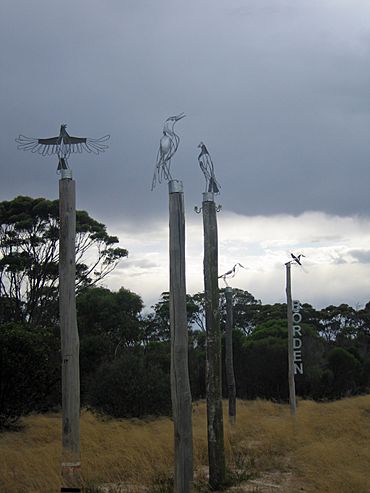Borden, Western Australia facts for kids
Quick facts for kids BordenWestern Australia |
|
|---|---|

Welcome to Borden
|
|
| Established | 1912 |
| Postcode(s) | 6338 |
| Area | [convert: needs a number] |
| Location | |
| LGA(s) | Shire of Gnowangerup |
| State electorate(s) | Roe |
| Federal Division(s) | O'Connor |
Borden is a small town located in the Great Southern region of Western Australia. It's about 325 kilometers (202 miles) southeast of Perth, the state capital. You can also find it about 111 kilometers (69 miles) north of Albany on Chester Pass Road. In 2006, Borden and the areas around it had a population of 164 people.
Contents
Discovering Borden's History
How Borden Got Its Name
Borden started as a stop along the Ongerup branch railway. This railway connected Gnowangerup and Ongerup. The town was named after Robert Borden, who was a Prime Minister of Canada. Another stop on the railway, called Laurier, was also named after a Canadian Prime Minister, Wilfrid Laurier. The railway opened in 1913 but closed in 1957.
Early Days and Development
Even before the town was officially set up, the area near Paper Collar Creek was a popular meeting spot. In the 1840s, people who cut sandalwood would gather here before heading to the port in Albany.
In 1916, a large piece of land was put aside for the town. Even though the land hadn't been fully measured yet, people started building. J.G. Jenkins built the first building, which had rooms for living, dining, and meetings. Another person, J. Copeland, was also building at that time. Borden also got a telephone connection to Gnowangerup, and mail arrived twice a week by train.
The Agricultural Hall
In 1928, a special building called the agricultural hall was opened. It was made from jarrah wood and cast iron. Important people like the Minister of Lands, Michael H. Troy, were there for the opening. This hall was an important place for the local farming community.
Farming Life in Borden
Wheat Farming and Grain Storage
The main industry in Borden is wheat farming. The town has a large grain receival site run by Cooperative Bulk Handling. This is where farmers bring their harvested grain. The bins at the site can hold a massive 170,000 tonnes (167,319 long tons) of grain during harvest season.
Flooding Challenges
In 2017, the grain receival site faced a big challenge when it was flooded after heavy rain. This happened during a record-breaking harvest, which meant a lot of grain was stored in extra bins. The floodwaters covered parts of the site.


